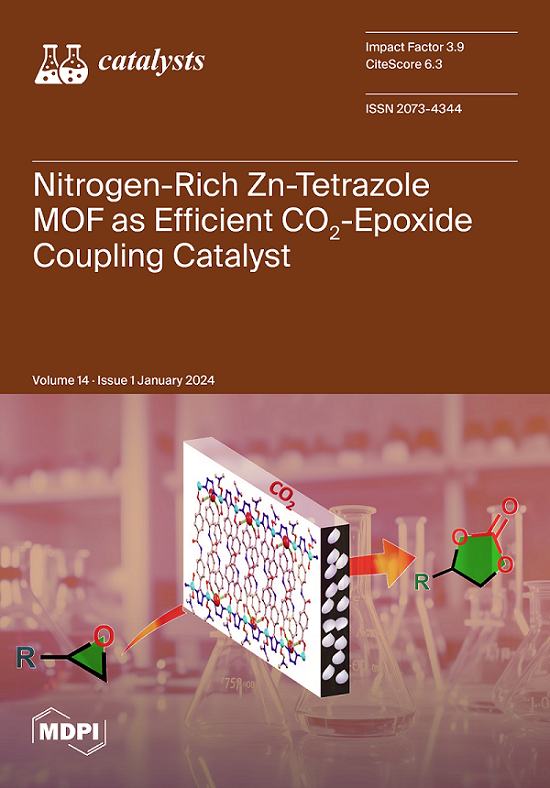Sodium Promoted FeZn@SiO2-C Catalysts for Sustainable Production of Low Olefins by CO2 Hydrogenation
IF 4
3区 化学
Q2 CHEMISTRY, PHYSICAL
引用次数: 0
Abstract
A prepared FeZnNa@SiO2-C catalyst with graphitized carbon (C)-modified mesoporous SiO2 supports metal nanoparticles with the sol–gel method. The effect of adding metal Na and Zn promoters as a dispersion on the CO2 hydrogenation to low olefins was systematically studied. The results showed that Zn–Na, as a combination, could promote the absorption of CO2 and improved the conversion rate of CO2. Na as an alkaline substance can improve the absorption of more acidic CO2, which could increase the conversion rate of CO2 to 59.03%. Meanwhile, the addition of secondary metal Zn to Fe-based catalysts to form a surface alloy could alter the adsorption of CO2 and the activation of C-O bonds, inhibit the subsequent hydrogenation of olefins to paraffins, and facilitate the reduction of Fe2O3 and the formation of active Fe5C2 species. The formation of active Fe5C2 species was found in TEM and XRD, and the selectivity of the target product was 41.07%. The deep hydrogenation of olefins was inhibited, and the space–time yield (STY) of low olefins was raised again by inhibiting their deep hydrogenations, up to 0.0436. However, the corresponding STY did not increase infinitely with the increase of Na doping, and higher catalytic performance for CO2 hydrogenation could be exhibited when the Na doping reached 6.4%. Compared with Fe@SiO2-C catalyst, Na- and Zn-promoted Fe-based catalysts, prepared by the modified sol-gel method, can be used directly for highly efficient CO2 hydrogenation to low olefins and thus has a more promising application prospect in the future.钠促进的 FeZn@SiO2-C 催化剂通过二氧化碳加氢实现低烯烃的可持续生产
采用溶胶-凝胶法制备了FeZnNa@SiO2-C催化剂,该催化剂以石墨化碳(C)修饰的介孔SiO2为金属纳米颗粒支撑。系统研究了添加分散金属 Na 和 Zn 促进剂对 CO2 加氢制取低烯烃的影响。结果表明,Zn-Na 组合能促进 CO2 的吸收,提高 CO2 的转化率。Na 作为一种碱性物质,可以改善对酸性较强的 CO2 的吸收,从而将 CO2 的转化率提高到 59.03%。同时,在铁基催化剂中加入次生金属 Zn 形成表面合金,可以改变 CO2 的吸附和 C-O 键的活化,抑制烯烃向石蜡的后续氢化,促进 Fe2O3 的还原和活性 Fe5C2 物种的形成。在 TEM 和 XRD 中发现了活性 Fe5C2 物种的形成,目标产物的选择性为 41.07%。通过抑制烯烃的深度氢化,低烯烃的时空产率(STY)再次提高,达到 0.0436。然而,相应的 STY 并没有随着 Na 掺杂量的增加而无限提高,当 Na 掺杂量达到 6.4% 时,CO2 加氢的催化性能更高。与Fe@SiO2-C催化剂相比,改良溶胶-凝胶法制备的Na-和Zn促进的Fe基催化剂可直接用于高效CO2加氢制取低烯烃,因此在未来具有更广阔的应用前景。
本文章由计算机程序翻译,如有差异,请以英文原文为准。
求助全文
约1分钟内获得全文
求助全文
来源期刊

Catalysts
CHEMISTRY, PHYSICAL-
CiteScore
6.80
自引率
7.70%
发文量
1330
审稿时长
3 months
期刊介绍:
Catalysts (ISSN 2073-4344) is an international open access journal of catalysts and catalyzed reactions. Catalysts publishes reviews, regular research papers (articles) and short communications. Our aim is to encourage scientists to publish their experimental and theoretical results in as much detail as possible. Therefore, there is no restriction on the length of the papers. The full experimental details must be provided so that the results can be reproduced.
 求助内容:
求助内容: 应助结果提醒方式:
应助结果提醒方式:


